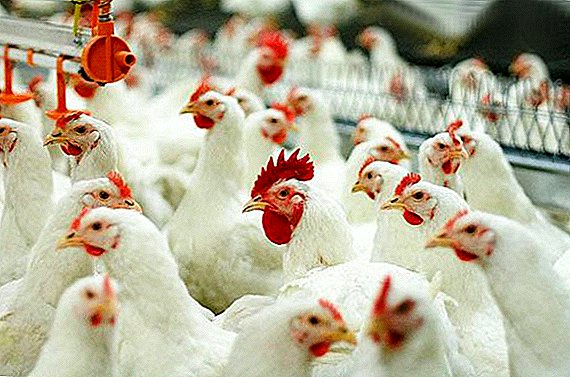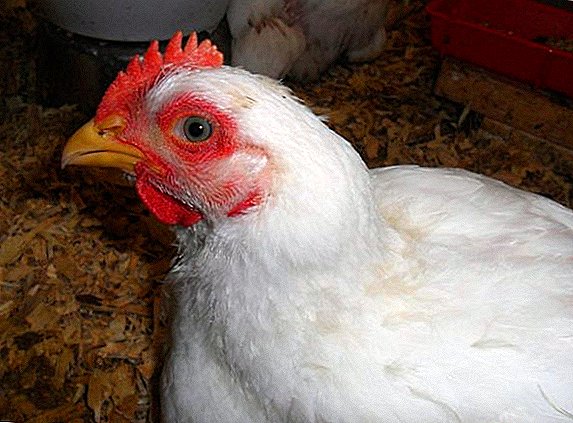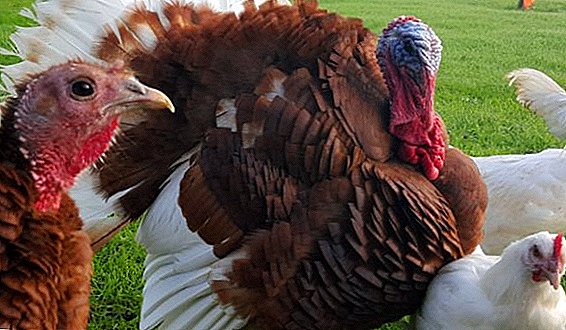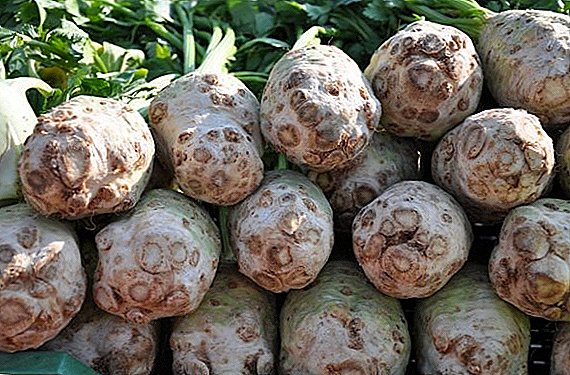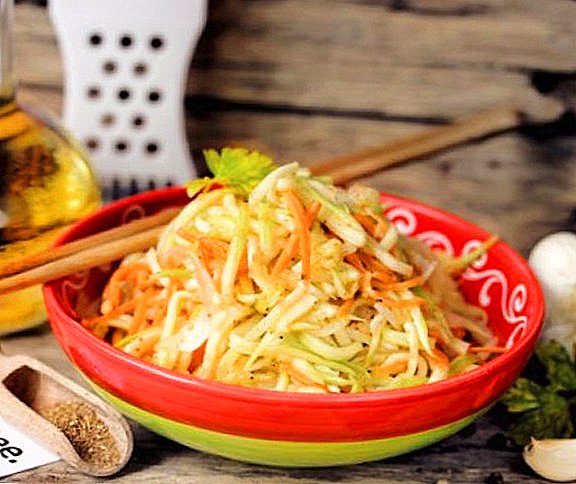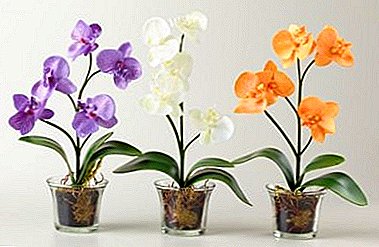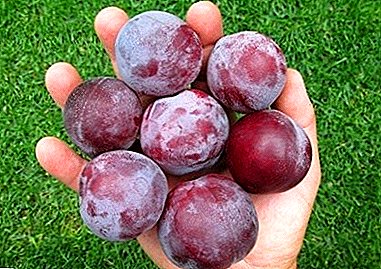
Chinese plums they are very different from ordinary home ones in appearance and taste, however, they have not yet received widespread distribution in our latitudes.
They appeared in Russia not so long ago, but with their use many new remarkable varieties and hybrids of plums have already been obtained.
Chinese plum variety Alenushka specially bred for growing in a fairly harsh climate of the middle zone of the Russian Federation.
This variety appeared very recently and few gardeners know about it.
Description of plum Alyonushka
Plum "Alenushka" description:
- Tree Alyonushka is low, about 2-2.5 m, with a pyramidal, not very thick crown. The shoots are strong, straight, reddish in color, with small internodes, not hairy. Buds conical, medium-sized, not pressed to escape.
The leaves are long, sharp, light green shade, dull. Along the edges of the sheet are small teeth, the tip and the base are pointed. The scape is long, not very thick.
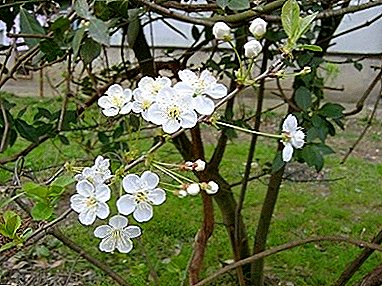 Flowers lush, large, white, very beautiful. Grow 3 pieces in the inflorescence, so the Chinese plum is often called three-flowered. During flowering shoots are completely covered with flowers.
Flowers lush, large, white, very beautiful. Grow 3 pieces in the inflorescence, so the Chinese plum is often called three-flowered. During flowering shoots are completely covered with flowers.- Berries This variety is very beautiful, large, weighing about 40-50 grams, spherical. The skin is thin, but strong, red or dark pink in color, with a noticeable waxy coating.
The flesh is bright orange, fairly dense, very juicy, with a thick pleasant aroma, sweet and sour, the taste is strongly reminiscent of a peach.
The fruits keep well on a short, thick stalk, and do not crack when overripe. The bone is medium-large, not separated from the pulp.
A photo
Visually get acquainted with the plum "Alenushka" can be in the photo below:



Breeding history and breeding region
Alenushka was obtained by crossing an early variety of Chinese plum Red ball with large-fruited late Chinese women. The breeders of the Oryol selection institute G. B. Zhdanov and A.F. Kolesnikov. The variety was zoned in 2001 in all of the Central Black Earth regions of the Russian Federation.
Characteristics of a variety
Plum Alenushka is an early ripe grade of table appointment. Berries are mainly consumed fresh, but they are also good in compotes or jams. Fruits tolerate transportation, but are not stored for long enough.
Fruit this variety is starting early, at 3 years after disembarkation. Alyonushka blooms before the first leaves appear, at the very beginning of May. Flowering is very abundant and beautiful, however, short. Productivity is not too high, but is stable annually. Harvesting can begin in early August.
This plum variety is self-infertile, therefore pollinating varieties must be located next to each other. For Alyonushka, the Skoroplodnaya variety will be the best pollinator, but any varieties of cherry plum or Chinese plum with the same early ripening are well suited for this purpose.
Find out what else there are varieties of Chinese plum: Orel dream, Skoroplodnaya, Xenia, Yellow Hopty.
Plum Alenushka, when grown in the middle lane, extremely frost resistant. It can withstand very severe frosts, down to -37 and even -40C, and can not tolerate warm and snowy winters. In such winters, she often has bark in the lower part of the trunk, which not only can reduce the yield, but also destroy the tree.
Therefore, this variety is better to grow on resistant formative formers, or choose to plant a place on a hill.
Planting and care
The best time for landing Alyonushka is autumn, and the place is open, high and sunny, with low groundwater levels, best on hills. The soil should be fertile, not acidic and not salty, light. Prepare it about a month before planting.

The selected area is well dug up, remove all weeds and, if necessary, lime.
Then prepare the pit, as for Alenushka, and for 3-4 pollinating varieties, strictly following the planting pattern: 5 * 3 m.
For Chinese plum pits make small: a depth of 40-50 cm and the same width. Then there are added 2 buckets of well-rotted manure, half a bucket of dolomite flour, some ash and 200 g each of superphosphate and potassium sulphate, mix everything thoroughly and put a small hillock from the top layer of soil in the center of the pit. A sapling is carefully placed on it and the roots are instilled in clean, fertile soil.
At the same time, the root neck is buried in the soil by 2-3 cm. After planting, the tree is plentiful (40-50 l) and watered and mulch the hole. For the best survival rate of seedlings, in the first month after planting it is watered more often, not allowing the soil to dry. Then reduce watering. To reduce the risk of bark bark, for the winter, the trunks of the seedlings are tied with fir branches.
The following year, in the spring, Alenushka begin to feed with nitrogen fertilizers (urea or ammonium nitrate). At the same time carry out the forming pruning. The main trunk is slightly shortened, and the side branches are cut a few cm below its top.
In the summer also spend feeding, at least 2 times. Used for this solution of phosphorus-potassium fertilizers with the addition of a small amount of wood ash. In addition, be sure to regularly weed, loosen and water the soil. In dry and hot weather, water is plentiful and frequent.
In the spring, trees are necessarily treated with special preparations for protection against diseases and pests, and they also carefully examine the crown and cut off all diseased and frozen branches.
Diseases and pests
Sort Alyonushka It is sufficiently resistant to such diseases as kleasterospiosis and moniliosis. Almost never affected by other fungal diseases. However, annually suffers from massive attacks plum aphid.
This small but dangerous pest feeds on the leaves and shoots of plum. You can find it on the bottom side of the sheet. The affected leaves very quickly turn pale, curl and dry, and the tree becomes very weak and stops growing.
Aphid hibernates in the bark of the main branches, near the buds and is activated at the beginning of flowering, in May. It is therefore very important to carry out the processing of wood in advance, before the buds swell.
First of all, remove all the old bark, dry leaves and branches, carry out weeding and loosening the soil around the trunk. Then carefully spray the tree with any insecticide (for example, Iskra).
You can use folk remedies: a solution of soap, infusion of potato leaves or tobacco with the addition of lime. Well help in the fight against aphids onion or garlic decoction, infusion of pharmaceutical chamomile or wormwood.
In the autumn, after the leaves have completely dropped, you can spray the plum with a concentrated urea solution and be sure to lime the stems.
Care for Chinese plum is not a big deal. If in time to carry out all the necessary measures for the care and protection of the plant, it is possible to ensure a good harvest of exceptionally tasty and healthy berries.
Sort Alyonushka has a huge amount merits:
 high frost resistance;
high frost resistance;- good yield;
- small size and decorativeness of the tree;
- large fruits;
- great taste and appearance of berries;
- resistance to kleasterospioz and moniliosis.
disadvantages:
- self-infertility;
- strongly affected by aphids.
Chinese plum variety Alenushka perfect for growing in their own summer cottage. This is one of the best varieties for mid-latitudes.
It is successfully grown in industrial gardening, and with good care, can become a real decoration of any garden.


 Flowers lush, large, white, very beautiful. Grow 3 pieces in the inflorescence, so the Chinese plum is often called three-flowered. During flowering shoots are completely covered with flowers.
Flowers lush, large, white, very beautiful. Grow 3 pieces in the inflorescence, so the Chinese plum is often called three-flowered. During flowering shoots are completely covered with flowers. high frost resistance;
high frost resistance;
